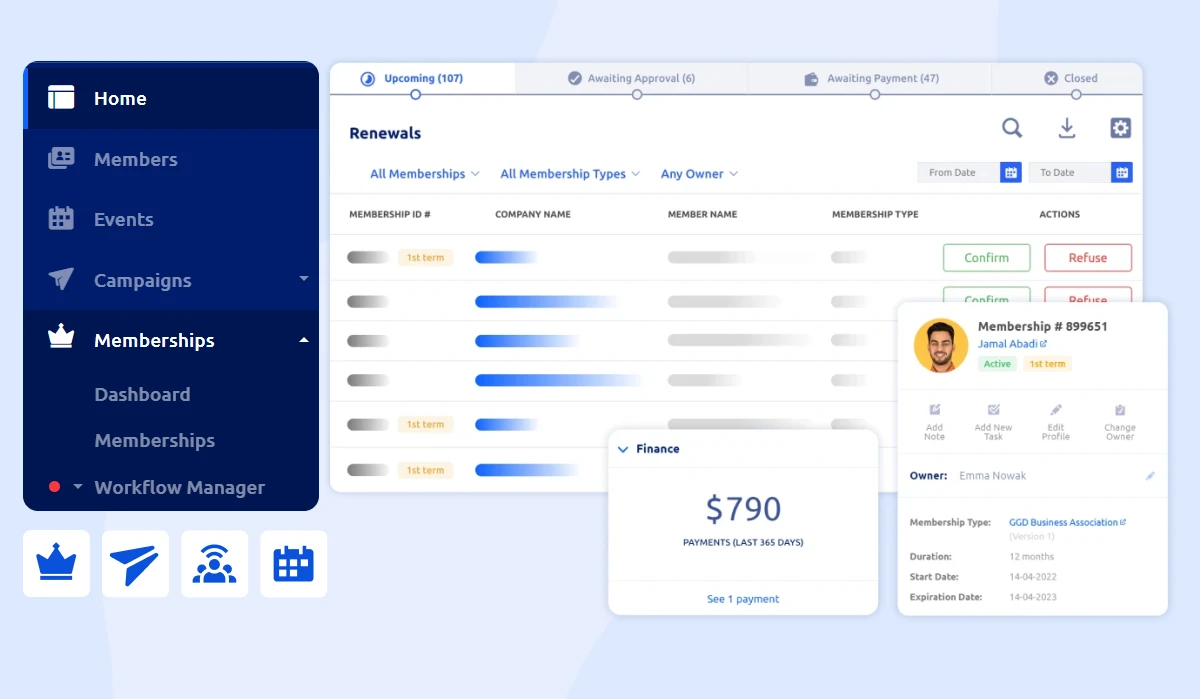
Associations are constantly seeking innovative ways to attract and retain customers. One such strategy that is gaining popularity across various industries is trial membership. Offering potential members a limited-time, no-obligation opportunity to experience a service can be a powerful tool in a company's arsenal.
Like any business tactic, trial memberships have advantages and drawbacks. In this blog, we'll explore the world of trial memberships, determining how they work, the benefits they offer to both organizations and members, and the potential risks to be aware of.
However, if you're a membership-based organization considering implementing a trial membership program or a consumer contemplating signing up for one, this detailed guide will provide you with the insights you need to make an informed decision.
Key Takeaways
- Trial memberships can be a valuable tool for attracting and retaining members.
- Careful planning is essential for a successful trial membership program.
- Balancing benefits and exclusivity is crucial for maintaining member satisfaction.
- Measuring key performance indicators helps evaluate the program's effectiveness.
- Glue Up offers comprehensive features to support trial membership management and overall association success.
Understanding Trial Memberships in the Association Context
A trial membership offers potential members a limited-time opportunity to experience the benefits of association membership firsthand. It serves as a valuable tool for generating interest, building trust, and ultimately converting prospects into full-fledged members.
Providing your potential members with a taste of the member experience puts you in a position where associations can showcase the value proposition and demonstrate the advantages of joining. This approach can be particularly effective in attracting new members and retaining existing ones.
Let's explore the building blocks of a successful trial membership program.
Types of Associations Considering Trial Memberships
Trial memberships can be particularly beneficial for certain types of associations, but there is a lot more to cover when it comes to trial membership. According to statistics, just 32.4% of membership sites offer a free trial, with the most common trial length being 7 days. This indicates that many organizations need to consider offering trials, whether free or paid.
These trials allow potential members to experience the association's value firsthand, increasing the likelihood of long-term commitment and engagement.
Here are some examples:
- Professional Associations: Offering a trial membership can attract potential members by showcasing the value of professional networking, educational resources, directories, and career advancement opportunities.
- Industry Associations: Trial memberships can be used to demonstrate the benefits of industry membership, such as access to market research, policy advocacy, and networking events.
- Non-profit Associations: This model can help build awareness of the organization's mission and generate support for its cause.
- Alumni Associations: Trial memberships can be used to reconnect graduates with their alma mater and encourage lifelong engagement.
Careful consideration of their target audience and value proposition allows these types of associations to effectively capitalize on trial memberships to increase membership acquisition and retention.
Advantages of Offering Trial Memberships for Associations
Trial memberships attract hesitant potential members and increase conversion rates. Such membership offers a risk-free way to experience the association's value, inspire a sense of community, and encourage long-term memberships.
Let's explore some of the most notable advantages trial membership can offer.
Boosting Member Acquisition: A Low-Risk Entry Point
Trial memberships provide potential members with a low-risk opportunity to explore the benefits of joining without committing to a full membership. This can attract a wider range of prospects and increase the likelihood of conversions.
Showcasing Value: Giving Prospects a Taste of Benefits
When offering a trial membership, associations can demonstrate the value proposition and showcase the benefits of membership firsthand, allowing potential members to experience the organization's offerings and make informed decisions.
Increasing Engagement: From Curious Onlookers to Active Participants
Trial memberships can transform curious onlookers into active participants. Providing such prospects with a taste of the member experience lets associations trigger a sense of belonging and boosts deeper engagement.
Data Collection: Understanding Potential Member Needs
Trial memberships offer valuable insights into potential members' preferences and needs. Organizations can gather data on trial member behavior and tailor their membership offerings and marketing strategies accordingly.
Competitive Edge: Standing Out in a Crowded Field
Offering a trial membership can differentiate an association from competitors. Associations provide a risk-free opportunity to experience the benefits and attract members who are hesitant to commit to a full membership upfront.
Potential Drawbacks of Association Trial Memberships

Everything comes with its advantages and disadvantages, and trial memberships are no exception. While we've discussed the benefits, it's important to highlight some potential drawbacks.
Diluting Exclusive Benefits: Balancing Access and Value
Offering trial memberships might dilute the perceived value of full membership if trial members gain access to core benefits. Striking a balance between providing a compelling trial experience and maintaining exclusivity for full members is important.
Resource Allocation: Managing Short-Term Members
Managing an influx of trial members can strain resources, particularly in areas like customer support and content delivery. Careful planning and resource allocation are necessary to confirm a smooth trial experience without compromising service to existing members.
Conversion Challenges: From Trial to Full Membership
Converting trial members into full-fledged members can be challenging. Many trial members may not see sufficient value to justify the full membership cost, leading to a lower conversion rate.
Potential for Membership Churn: The Revolving Door Effect
A high turnover rate among trial members can create a revolving door effect, impacting overall membership stability. Effective onboarding and retention strategies are crucial to counter this risk.
Impact on Existing Members: Perceptions and Reactions
Some existing members may perceive trial memberships as unfair or devaluing their full membership status. Addressing potential concerns and communicating the benefits of trial memberships to current members is essential to maintain satisfaction.
Structuring an Effective Association Trial Membership
Creating an effective trial membership involves offering clear value and providing access to key resources and events. Certifying a smooth onboarding process and having a strategy to convert trial members to full members is essential for success.
Let's find out how to achieve this.
Determining the Optimal Trial Duration
The length of the trial period significantly impacts member experience. A trial that is too short may not provide sufficient time to assess value, while an overly long trial can lead to decreased perceived value of full membership. Finding the right balance is a must.
Selecting Benefits to Include (and Exclude)
It is important to carefully choose which benefits to offer during the trial period. Include core value propositions that demonstrate the association's worth, excluding exclusive perks reserved for full members.
Pricing Strategies: Free vs. Reduced-Fee Trials
Deciding whether to offer a free or reduced-fee trial depends on various factors, including target audience, budget, and desired outcomes. A free trial can attract a larger audience, while a reduced-fee trial may signal greater value.
Creating a Smooth Transition to Full Membership
Develop a clear and compelling pathway for trial members to convert to full membership. To facilitate the transition, offer incentives, highlight additional benefits, and provide excellent customer support.
Marketing Association Trial Memberships
Effectively marketing trial memberships involves utilizing multiple channels. Leveraging digital platforms and personal outreach can maximize reach and impact.
Let's explore how to do this successfully.
Targeting the Right Audience: Who Benefits Most?
Identifying and targeting the right audience is crucial for the success of a trial membership program. It is better to explore which demographics and customer segments are most likely to benefit from trial memberships and how businesses can tailor their offerings to meet the specific needs of these groups.
Crafting Compelling Trial Membership Campaigns
A well-crafted trial membership campaign can make all the difference in converting potential members into loyal customers. Effective strategies for designing and promoting trial membership offers that resonate with your target audience can drive engagement.
Leveraging Social Proof: Success Stories and Testimonials
Social proof is a powerful motivator when it comes to convincing potential members to join. Highlight how showcasing success stories and testimonials from satisfied trial members can enhance the credibility of your program and encourage others to join.
Measuring the Success of Trial Membership Programs

Measuring the success of trial membership programs involves tracking conversion rates, member engagement, and feedback. Analyzing these metrics helps refine and improve the program.
Here is how you can measure the success of your trial membership program
Key Performance Indicators for Association Trials
Tracking specific metrics is necessary for evaluating the effectiveness of a trial membership program. Key performance indicators (KPIs) include conversion rates, trial completion rates, and member satisfaction.
Tracking Conversion Rates and Member Retention
Monitoring the percentage of trial members who convert to full memberships is crucial. Additionally, tracking member retention among those who do convert provides valuable insights into long-term program success.
Gathering and Analyzing Feedback from Trial Members
Collecting feedback from trial members through surveys or interviews can help identify areas for improvement and uncover opportunities to enhance the member experience. Analyzing this feedback can lead to data-driven decisions for refining the trial program.
Legal and Ethical Considerations
There are important legal and ethical considerations when offering trial memberships.
Let's find out what these considerations entail.
Ensuring Transparency in Trial Terms and Conditions
Clearly outlining the terms and conditions of the trial membership is essential to avoid misunderstandings and legal issues. Providing detailed information about benefits, limitations, and cancellation policies builds trust with potential members.
Protecting Member Data and Privacy
Handling member information responsibly is crucial. Implementing robust data protection measures to safeguard personal information is essential to maintaining trust and complying with relevant regulations.
Maintaining Fairness: Trial vs. Full Member Treatment
It is important to strike a balance between offering a compelling trial experience and preserving the value of full membership. Guaranteeing fair treatment for both trial and full members can help maintain satisfaction and prevent resentment.
The Impact on Association Culture and Community
Offering trial memberships can significantly impact an association's culture and community. It introduces fresh perspectives and diverse experiences, enriching the community dynamic.
However, it can also challenge existing norms and require adjustments to integrate new members effectively. Balancing these changes is key to maintaining a cohesive and welcoming environment.
Let's explore how this unfolds.
Integrating Trial Members into the Association Ecosystem
Successfully incorporating trial members into the existing association community is crucial for cultivating a welcoming environment. Creating opportunities for interaction between trial and full members can enhance the overall member experience.
Maintaining Exclusivity While Welcoming New Faces
Balancing the need to provide a compelling trial experience with preserving the exclusivity of full membership is essential. Clearly defining the boundaries between trial and full membership benefits can help maintain a sense of value for existing members.
Encouraging Long-Term Member Buy-In for Trial Programs
To maximize the effectiveness of trial memberships, associations should focus on creating a positive and memorable experience for trial members. This can encourage them to become full members and contribute to the long-term success of the organization.
Case Studies: Associations That Got It Right (and Wrong)
We've talked a lot about trial memberships; now it's time to cite real examples. Examining associations that have successfully implemented trial memberships can provide valuable insights and best practices.
Similarly, learning from those who faced challenges or made mistakes can help avoid common pitfalls.
Let's dive into these case studies to understand what works and what doesn't.
Success Stories: Trials That Led to Membership Booms
Some notable success stories of trial memberships include Seedprod, which offers a 6-month trial and has seen significant membership growth as a result. YouTube Premium's free trial has also led to a substantial increase in subscribers, demonstrating the effectiveness of this approach.
WordPress Beginner's free resources and trial periods have successfully converted numerous trial users into loyal members. These examples highlight how well-structured trial programs can lead to membership booms.
Cautionary Tales: When Trial Programs Backfired
While there aren't prominent examples of trial programs backfiring, associations should still exercise caution when offering trial memberships. To avoid potential risks, assure clear communication of terms and conditions, protect member data, and provide genuine value during the trial period.
Additionally, avoid overpromising and underdelivering, as this can lead to dissatisfaction and a negative reputation. Addressing these cautionary points will maximize the success of their trial membership programs.
Lessons Learned: Key Takeaways from Real-World Examples
Several key takeaways regarding trial membership programs emerge from real-world examples. Successful implementations, like those of Seedprod and YouTube Premium, show the importance of offering substantial value and a seamless onboarding process.
Clear communication and setting realistic expectations are crucial to maintaining member satisfaction. Ensuring data privacy and transparency builds trust and credibility. On the cautionary side, associations should avoid common pitfalls such as overpromising and underdelivering.
These lessons highlight the strategies and considerations essential for designing effective and impactful trial membership programs.
The Future of Association Trial Memberships
Emerging Trends in Membership Models
The association landscape is continually evolving, with new membership models and strategies emerging. Understanding these trends is essential for staying competitive and relevant.
Technology's Role in Enhancing Trial Experiences
Using technology can significantly improve the trial membership experience. Personalized recommendations, AI-powered chatbots, and data analytics can enhance member engagement and facilitate conversion.
Adapting to Changing Professional Landscapes
As the professional world evolves, associations must adapt their trial membership programs accordingly. Incorporating emerging trends, such as remote work and flexible learning formats, can attract a wider range of potential members.
Making the Decision: Is a Trial Membership Right for Your Association?

Assessing Your Association's Readiness
Before implementing a trial membership program, evaluate your association's current state. Consider factors such as membership growth, member engagement, and resource allocation.
Conducting a Cost-Benefit Analysis
Weigh the potential benefits of a trial membership program against the associated costs and resources required. Assess the expected return on investment and how it aligns with your organization's goals.
Strategies for Piloting a Trial Membership Program
Consider a phased approach to minimize risks. Start with a small pilot group to test the program's effectiveness before expanding it to a wider audience.
Conclusion: Balancing Opportunity and Risk
Recap of Key Advantages and Drawbacks
Trial memberships offer significant potential for boosting member acquisition and engagement. However, it's essential to weigh the benefits against potential challenges such as resource allocation and maintaining member satisfaction.
Final Thoughts on Implementing Trial Memberships
Ultimately, the decision to implement a trial membership program depends on your association's specific goals and circumstances. Before making a decision, carefully consider the potential impact on membership structure, resource allocation, and overall member experience.
Careful planning and execution make your trial membership program maximize its benefits and minimize potential drawbacks.
Managing Membership Trials with Glue Up

If you've decided to offer a membership trial, do it with efficient membership management software like Glue Up. The software allows you to easily add the membership trial type, track enrollments, and monitor other key metrics.
Glue Up offers a range of features tailored for associations:
- Membership Management: Streamline the onboarding process, manage member data, and track engagement.
- Auto Renewals: Automatically renew memberships, reducing manual work and ensuring continuity.
- Recurring Payments: Set up recurring billing for hassle-free payment collection and improved cash flow.
- Auto-Generated Invoices: Generate and send invoices automatically, simplifying financial administration.
- Finance Management: Keep track of financial transactions, budget reports, and accounting within the platform.
- AI Copilot: Utilize AI-driven insights and automation to enhance member engagement and operational efficiency.
- Event Management: Plan, promote, and manage events seamlessly with tools for registration, ticketing, and attendee tracking.
- Community Management: Promote member interaction and networking through forums, groups, and discussion boards.
- Member Benefits: Offer and manage exclusive benefits, discounts, and resources for your members.
- CRM and Campaigns: Manage relationships and communication with members using integrated CRM tools and marketing campaigns.
Consider booking a demo for more information on how Glue Up can help you manage your association's members.



